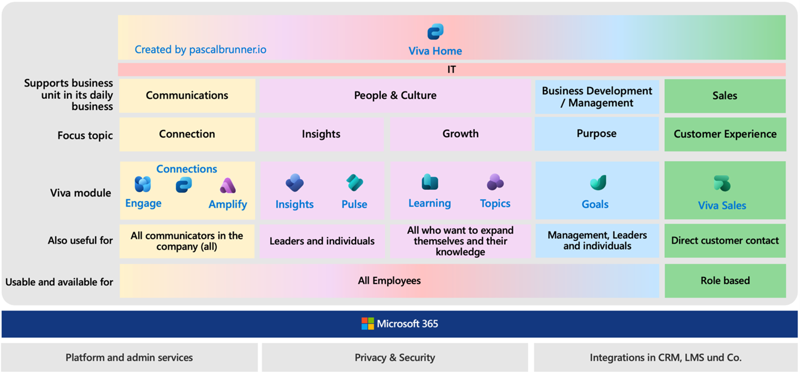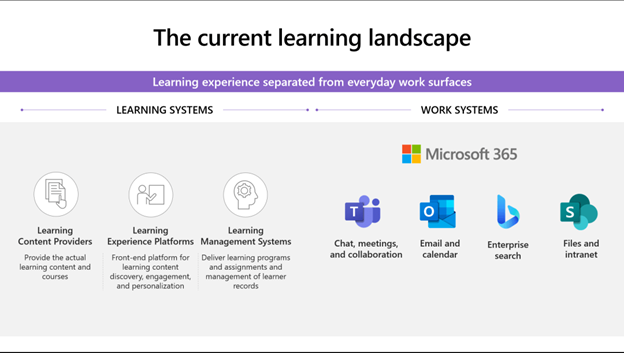Why the Business Should Lead Microsoft Viva Projects, Not IT
In addition to the current discussions around OpenAI, ChatGPT, and the recently announced Microsoft Copilot, employee experience is a topic that occupies me intensively. For those of you who are not familiar with the term, employee experience is, as the term implies, about companies taking care of the experience that their employees have. Similar to customer experience, this includes the experience from the first point of contact until the employee leaves the company. It also includes the time that employees spend with the company. Microsoft Viva is Microsoft's answer to providing organizations with an employee experience that takes place in a workflow, which also contributes to a good employee experience. Currently, Viva modules are grouped into four overarching pillars: Growth, Connection, Purpose, and Insights.
I would like to drive deeper awareness and understanding of employee experience. In various conversations, I always find a similar situation. People are very interested in understanding employee experience, or more precisely Microsoft Viva. However, they still have difficulty grasping the whole potential of an integrated employee experience.
In my opinion, there are several reasons:
- Companies are still dealing with ad-hoc effects of the pandemic. They are working out and implementing governance, trying to successfully implement teams, and creating a general understanding of Microsoft 365. Therefore, they haven’t yet had a chance to invest in new approaches such as employee experience.
- For other organizations and business decision makers Microsoft Viva is interesting, but they have difficulty accessing the employee experience platform and assessing who is responsible for what.
Microsoft Teams Sets the Foundation
Microsoft 365, especially Microsoft Teams, is the foundation for Viva adoption. Organizations should already have the key building blocks of Microsoft 365 and the appropriate structures (for example, based on your org chart or project organization) in place, so that they can add Viva as the next building block.
The “Worth-It-Equation”
As we have learned from the Work Trend Index 2022, employee needs have changed. There is even talk of a new equation that employees use when they start a new job to determine if it's worth it. Today, several factors play a role in this equation:
Flexibility x social contacts x meaning of work x salary review x [...] = attractiveness of employer.
Of course, this worth-it equation can vary depending on the industry. For example, working from home does not work equally well in all industries. Also, working from home is not the only measure of flexibility.
Why Microsoft Viva Is Not an IT Project
When a new tool is involved, implementation projects and operations are often assigned to the IT department. This approach may make sense from a technical perspective, but not from an end-user perspective. It’s clear that Viva and the goals of modules of the platform need to be located in different business units of a company, not in IT.

View Full Size
As Figure 1 shows, IT will always play a role in implementation projects and operations. However, it requires a change in mindset that IT is not necessarily the driver of Viva modules. Rather, the business unit, its know-how and, ultimately, its requirements are needed for a targeted implementation of an individual Viva module. With Viva Home, Microsoft is introducing an application in Teams that combines all Viva modules and the Viva Connections dashboard into a single view, further simplifying access to Viva modules.
Communications
The Microsoft Work Trend Index shows that 96 percent of managers and 95 percent of employees agree that effective communication is the most important skill to have today. To communicate effectively, you need a clear communication strategy and a tool that reaches all employees. And by all employees, we also mean the so-called frontline workers. If the past few years have shown us anything, it is that companies need to ensure that people do not feel isolated and disconnected at home. The Connection pillar in Viva addresses this issue. It's easy to integrate targeted communications into Viva, and therefore into the Microsoft 365 world, for different needs and use cases. The following are examples of internal communication tools:
- Viva Connections: SharePoint Online intranet with additional features directly in Teams.
- Viva Engage (formerly Yammer): An employee experience where you can create and communicate within communities.
- Viva Amplify: The new tool for campaign-oriented and measurable communication. With a few clicks, you can share a message to different channels such as Facebook, Twitter, etc.
Of course, these tools not only refer to communications, but are useful for every employee and business unit.
People & Culture
From the perspective of the People & Culture department (also known as HR), there are challenges to address daily. One of them is the Growth pillar. On the one hand, many companies are facing a large wave of retirements. It is not uncommon for these people to have been with the company for a long time and to have a lot of tacit, undocumented knowledge about the company. On the other hand, documenting knowledge in a meaningful way is generally a major challenge.
Viva Topics enables a company to extract knowledge based on AI, and to consolidate it in the company through so-called topic owners.
The second module of the Growth pillar is all about learning on the job. We know that employees only have about 1 percent of their working time available for training.
If you look at the maps of today's learning systems, they are very often disconnected from the actual work environment. Learning cannot take place in the flow of work, but outside of it.

To make matters worse, today's learning content is spread across many different systems such as Microsoft Learn, LinkedIn Learning, SuccessFactor, Pluralsight, and others. Wouldn't it be great to have it all in one place? This is exactly what Viva Learning does. It provides not only an overarching learning hub, but also delivers a natural feeling of learning in the flow of work.
In my opinion, the Insight pillar belongs in the People & Culture pillar and Growth pillar. Viva Insights recognizes work patterns on different levels. Not only the feeling of disconnection as already mentioned, but also the tendency to overwork both pose dangers in the home office. The boundaries between personal and professional life are becoming increasingly blurred. A few steps and I am in the living room or at the refrigerator. More and more, you get the feeling: "Oh, I can do that quickly," and then two hours are gone. Viva Insights can help.
On a personal level, Viva Insights evaluates your work patterns, which are only visible to you. You can schedule your focus times, take a break with a headspace meditation, and more. There are also levels for company executives and managers. For privacy reasons, there are further evaluations for other sample work recognitions. For example, from a managerial perspective, you could see that about 50 percent of managers have not had a 1:1 meeting with their employees for more than a month, which in turn could indicate why employees feel disconnected.
These insights are available at three different levels, depending on the license and level:
- Leader
- Manager
- Individual
Privacy is always maintained, and there are no conclusions about individuals for leaders and managers. You can customize your data analysis with Power BI, enabling you to perform targeted analyses for greater insight into your organization.
From a People & Culture perspective, the internal pulse is a key factor. Today, you have to rely on third-party tools like Loopline. Microsoft is aware of the importance of this issue and has developed another module for Viva called Viva Pulse, which is expected to be available in 2023. Viva Pulse enables managers and team leads to get confidential feedback about their team’s experience, within Teams.
Business Development and Management
The next pillar is Purpose. As mentioned earlier, the meaning of work is an important component for employees. As an employee, you want to understand the impact that your daily work has on the company.
With Viva Goals, you can bring your company's objectives and key results (OKR) approach into Teams. This is where Business Development and Management come in. Although they don’t define the OKRs for the entire company, they are critical stakeholders in rolling out the OKR framework and thus Viva Goals.
The goal is to promote the OKR approach in the company, to create greater transparency and demonstrate to employees the relevance of people and their work.
Sales
Viva Sales is special in the Viva map in that it talks about a role-based experience. All sales calls take place remotely, and so there is a gap between the customer relationship management (CRM) tools and the working environment. You get a lot of information directly in a team meeting or via email.
With Viva Sales, sales reps can pull information from work environments like Teams or email directly into their CRM. Viva Sales works not only with Microsoft Dynamics 365, but also with Salesforce.
What’s Next?
This approach is nothing new and has been, or should be, used for all other Microsoft 365 tools: the business specifies the requirements and use cases, and implements them together with IT. The business needs to be aware of the capabilities of the tools (on the market), and there should be a step-by-step implementation. In the envisioning stage, I see IT again as an enabler, presenting the latest trends in the market to the business, so that the business can decide what is profitable and what is not.
As always, this is a chicken-and-egg question, but one that has great potential for the enterprise. The business must also support this approach. Both IT and the business units are usually very busy, so new things might be lower priority. It is often worth bringing in an external party to ensure that such issues are addressed with the necessary consistency.
I hope that this article has helped provide a better understanding that when it comes to an employee experience platform such as Microsoft Viva, you need to involve your business units in implementation, and not just IT.


